(Last updated on November 30th, 2022)
Final Cut Pro or DaVinci Resolve, which video editing software is better in 2023?
See this ultimate DaVinci Resolve vs Final Cut Pro comparison and find out which one is the best editing platform for YOU.
DaVinci Resolve and Final Cut Pro X are two of the most heavily used video editing platforms on the market for professionals. Both editing applications are top-of-the-line and can be used to edit anything from home movies, short films, commercials, to feature-length films.
However, these two video editing platforms vary significantly in terms of features, tools, interface, application, and other functions. Both DaVinci Resolve and Final Cut Pro X can be used on macOS and Windows operating systems.
Related: Premiere Pro vs DaVinci Resolve: The Ultimate Battle (2023)
As there are multiple different versions of these programs, when we refer to “Final Cut,” we are referring to Final Cut Pro X. Similarly, when we refer to “DaVinci,” we are referring to DaVinci Resolve Version 16.
Comparison at a Glance
1. Interface
Winner: DaVinci Resolve. DaVinci Resolve offers many different types of interfaces within its program tailored to editing, color correction, audio engineering, text and graphics, and media sourcing. Final Cut Pro’s interface is set up for an all-in-one interface that can feel easy to use but non-specialized.
2. Ease of Use
Winner: Final Cut Pro X. As an Apple product, Final Cut Pro may very well be the easiest to use of all professional video-editing platforms. This allows new editors to use Final Cut Pro efficiently. DaVinci Resolve has a steeper learning curve.
3. Color Correction
Winner: DaVinci Resolve. DaVinci Resolve was initially designed as a color correction tool, allowing colorists to specialize in fine coloring footage. That, however, has changed in recent years. While those same coloring tools are still available, DaVinci has opened its gates to video editors, facilitating the use of audio tools at the same time.
4. Audio
Winner: Tie. The ever-important audio engineering capabilities within both Final Cut Pro and DaVinci Resolve are powerful enough to turn a home movie into a high production value project.
5. Tools
Winner: DaVinci Resolve. The tools offered in both DaVinci and Final Cut are extensive and advanced. However, DaVinci prides itself on bringing new tools to its video-editing platform year after year. Now, in 2023, DaVinci competes with the best video editing platforms on the market, and it’s all thanks to its advanced and easy to use tools.
6. Text/Graphics
Winner: Final Cut Pro X. Final Cut Pro’s preset titles and customizable text allow you to create just about any title in a sleek and beautiful way. DaVinci has its fair share of text and graphics capabilities, but Final Cut Pro’s easy to use interface takes the cake.
7. Pricing
Winner: Tie. Both Final Cut Pro X and Davinci Resolve are offered for $299.
Short Verdict
Final Cut Pro offers low rendering and exporting times even for high-resolution videos, while DaVinci Resolve is a great option for users that focus heavily on color correction. Also, Final Cut Pro only works on Macs, whereas DaVinci Resolve is compatible with both PCs and Macs.
While DaVinci Resolve is not quite as popular as Final Cut Pro, the program is all-around better for a professional editor. Final Cut Pro has the ability to edit professional productions, but it is also designed for a beginner to gain skills as an editor. The main difference between the two programs is that Final Cut Pro has a magnetic timeline, whereas DaVinci Resolve has a non-linear timeline, which is what the industry standard is.
Final Cut Pro X and DaVinci Resolve are two of the most commonly used editing platforms in the world by professionals. Granted, Final Cut Pro may have a bigger hold on the market, there’s no denying the tools, features, and color correction base that DaVinci Resolve offers. And that explains why DaVinci Resolve is an editing platform that is growing fast and finding new users among the masses.
1. Interface
The interfaces of Final Cut Pro and DaVinci Resolve, while looking fairly similar, vary greatly in design and use. Final Cut Pro’s magnetic timeline is still its most quintessential feature, along with its effects panel, and quick playback in the program panel. The reason DaVinci wins this category is that DaVinci Resolve has several different interfaces to match the type of video editing you’re doing, whether it be graphics/text, audio, color correction, or structural editing.
We will begin with DaVinci’s media page, where you can import footage and create proxies for quick playback of high res or high bitrate assets. Here you can view the clip details within the program, potentially saving time in the backend.
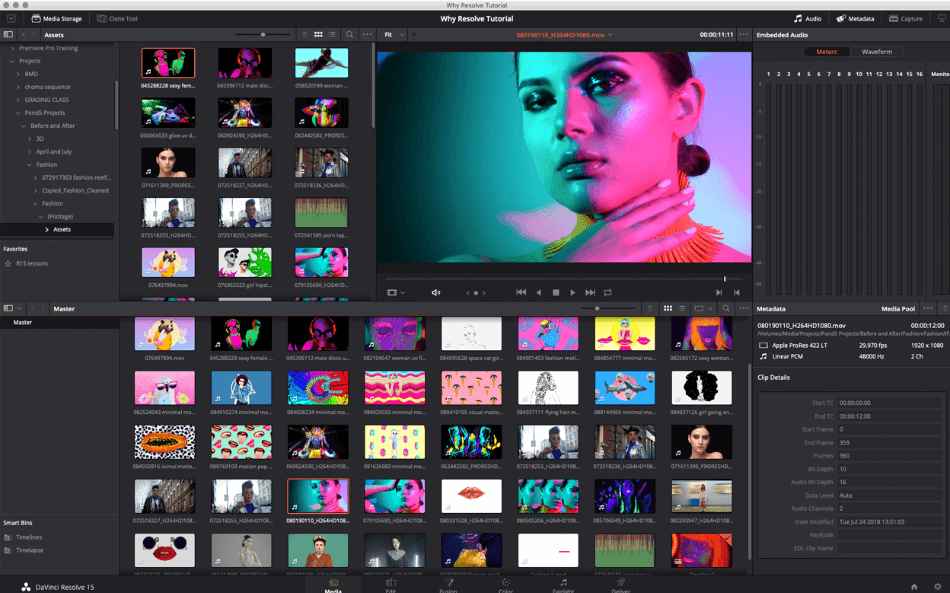
DaVinci’s edit interface is pretty self-explanatory, but you’ll definitely be spending most of your time here. This is where the basic video editing of clips and structuring out your timeline will take place. Here you’ll see three simple panels. On the left side, there is your media pool to select footage from to put into the timeline. On the bottom is the timeline where you’ll be making your cuts and manipulations. And on the top right, you have your preview panels where you can playback footage.
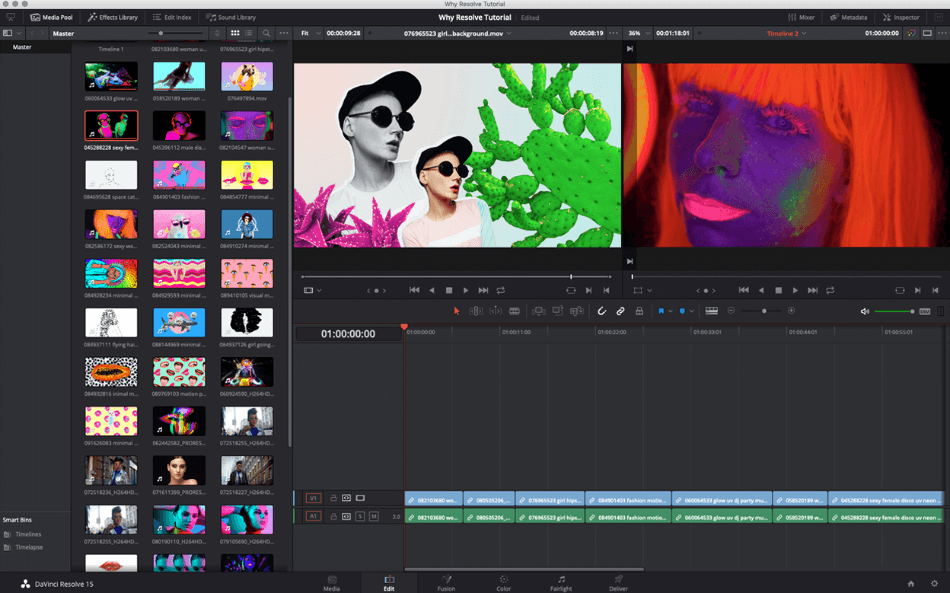
The next interface is the fusion interface. This is where all of the graphics will be applied, effects added, and text implemented. While this does have a bit of a learning curve to it, it’s not much when compared to other compositing platforms. On top of that, DaVinci’s design makes it quite simple to apply advanced custom effects.
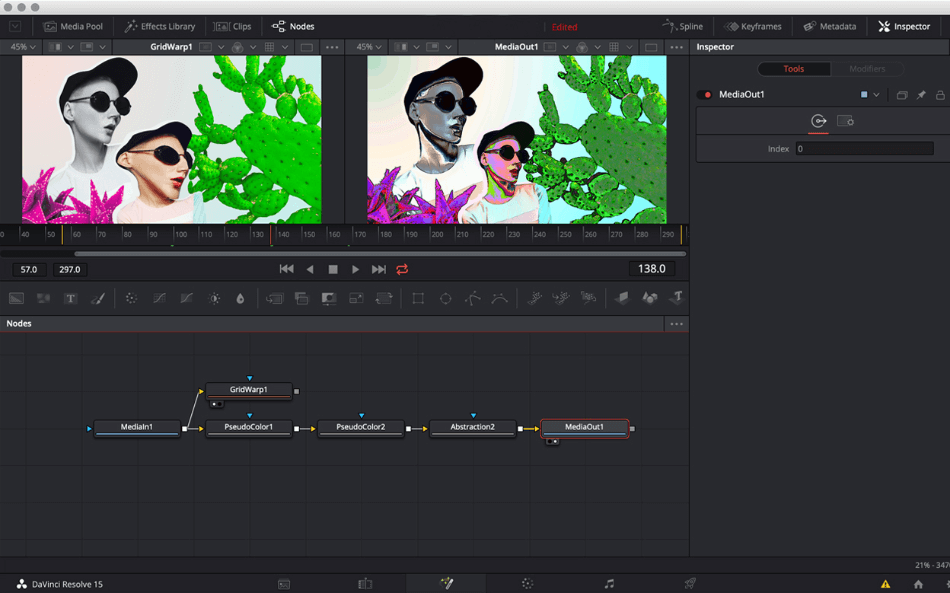
DaVinci Resolve’s color correction interface is its foundation and strongest interface. Here you can manipulate every small color detail within each frame to match the tone and mood of the rest of your project. We will dig into it later in the color correction category.
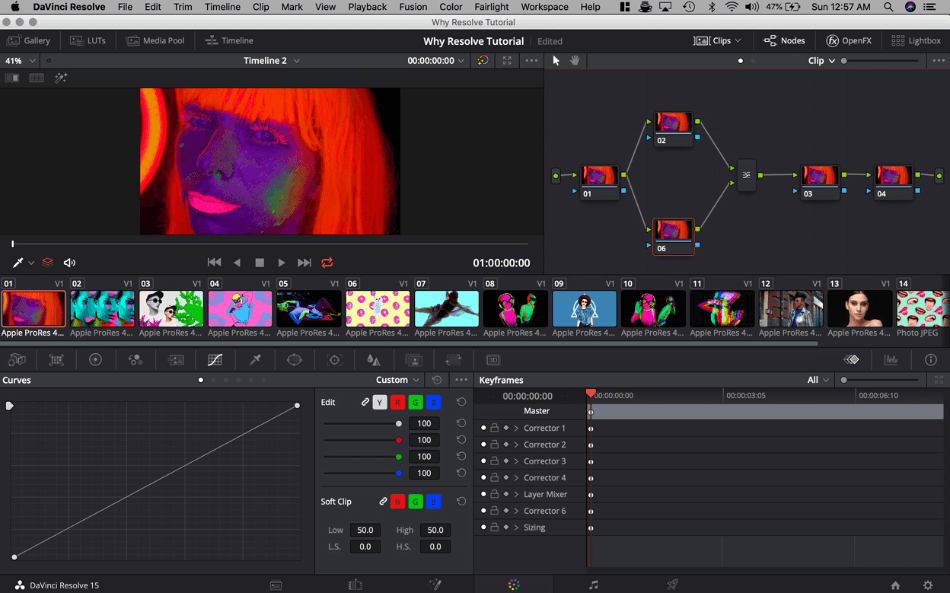
Finally, DaVinci’s Fairlight interface is where all of the audio engineering comes into play. In recent years, DaVinci has boosted up its audio tools to bring them up to the par and become a major player in the video editing industry. The interface also reflects that in its simple yet powerful layout.
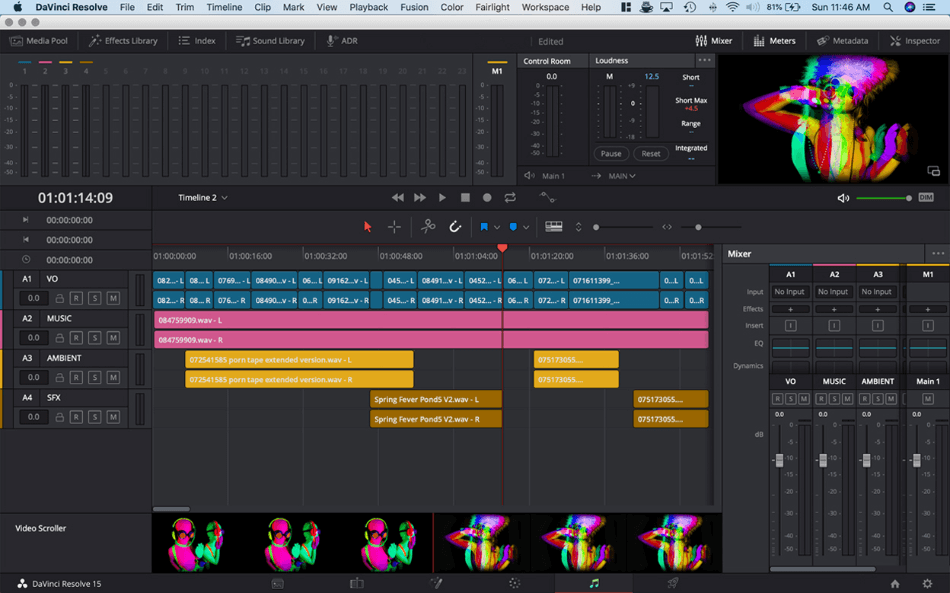
Final Cut Pro, on the other hand, has one universal interface. Its timeline on the bottom is magnetic, which means that if you delete a clip in the middle, the entire video will shift over. This can be aggravating to some editors and a blessing to others. The effects on the right side give you access to just about anything you can dream of. And the source panel in the upper left gives you access to your assets and raw footage.
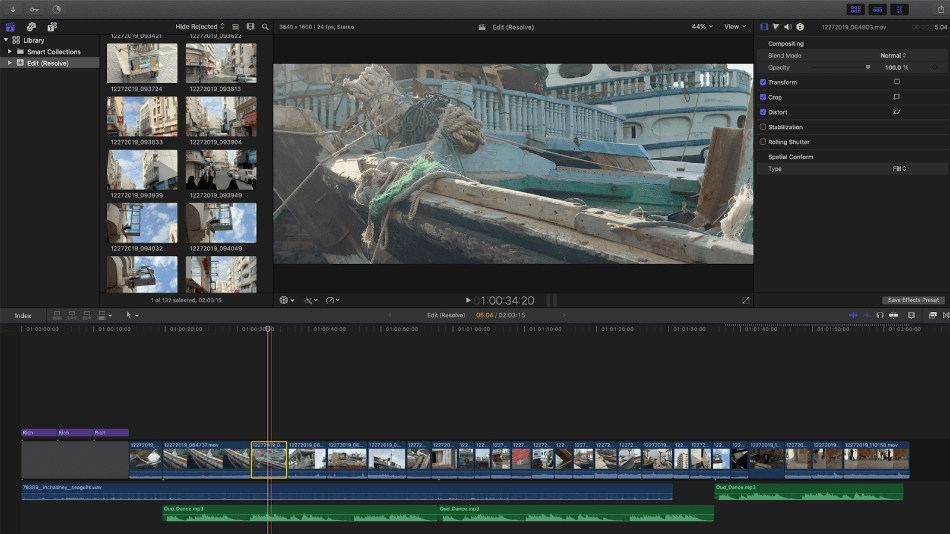
While the two interfaces allow you to edit masterpieces, they do it in their own way. And one may be better for you than the other. However, if you’re looking to excel in the video editing industry, DaVinci Resolve may be the program for you, as it contains more powerful tools for audio engineering, simple cuts as well as color correction.
Winner: DaVinci Resolve
2. Ease of Use
Final Cut Pro X is not only the easiest to use between itself and DaVinci, it is known for its user-friendliness even amongst more powerful video editing platforms. It is often viewed as a professional version of iMovie. Final Cut Pro’s magnetic timeline and embedded source footage limit the confusion of a first-time editor.
DaVinci, on the other hand, has a steeper learning curve. However, this means that the tools are better and more powerful. This is where, as an editor, you must choose which program is right for you.
Because playing back footage is an essential tool for beginners to see what they are doing, this makes it a top issue for ease of use. While every editing program has its share of laggy playback, DaVinci and Final Cut Pro are two of the smoothest platforms.
However, Final Cut Pro creates a project file that is enormous in size. This is beneficial for playback because instead of relying on the source file on the external hard drive or elsewhere, all the files are within the program.
Winner: Final Cut Pro X
3. Color Correction
Color correction is the category in which DaVinci Resolve dominates all other video editing programs, including Final Cut Pro. But let’s start with what Final Cut Pro has to offer. Final Cut Pro offers a wide variety of tools and features for color correction that can turn your footage into well-polished clips. With the recent addition of hue and saturation curves, color wheels and color curves, color correcting footage in Final Cut Pro is similar to that of other top-notch editing programs.
By giving access to an array of different tools in one place, Final Cut Pro enables quick and advanced color correction.
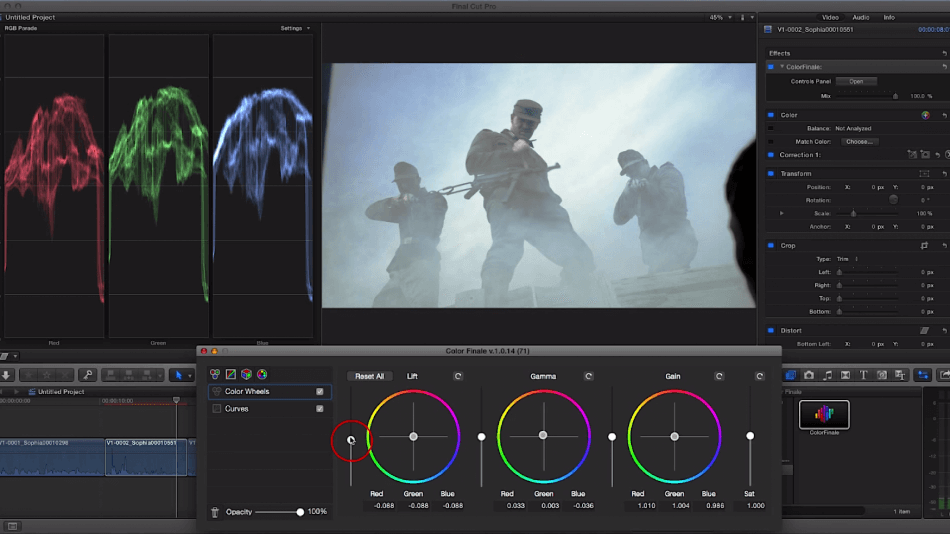
Another smart Final Cut Pro feature is the automatic color correction tool. The auto tool will plant on the best generic color correction to the clips you place it on. Granted, it won’t have a specific mood or feeling to it. It is still a neat and quick feature of this advanced system.
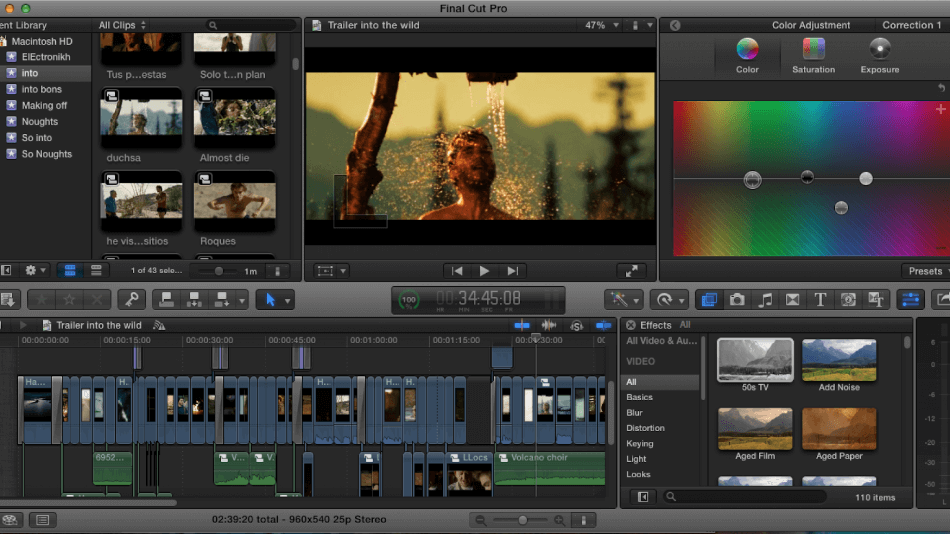
Now let’s get into what DaVinci has to offer. Let’s put it this way, any color correction palette or effect you can dream of, DaVinci can materialize it for you. Professional colorists had used DaVinci for years before it offered video editing capabilities. That’s right, professionals that ONLY color corrected chose to use DaVinci Resolve as their go-to tool.
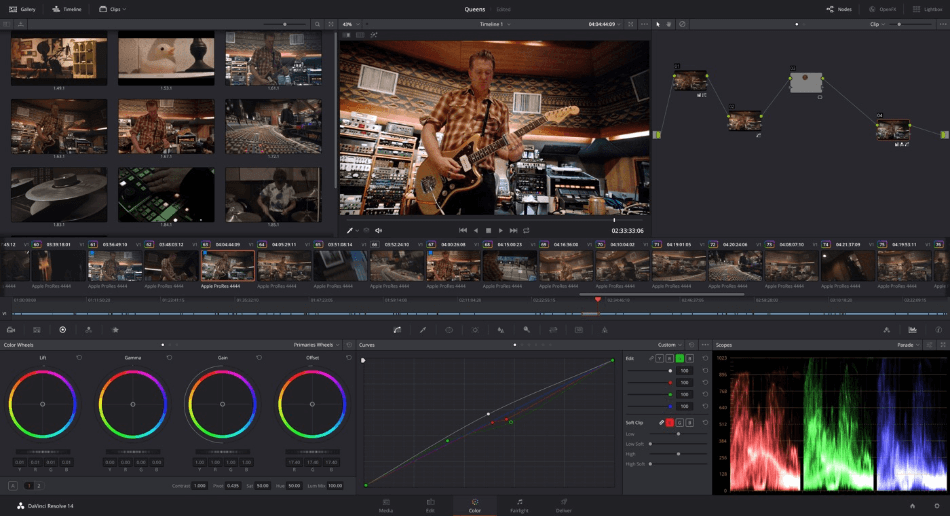
One nifty feature in the DaVinci Resolve color interface is the implementation of stills in the upper left corner. This allows you to quickly compare clips and how they match up. This simple feature is unparalleled by any other editing program.
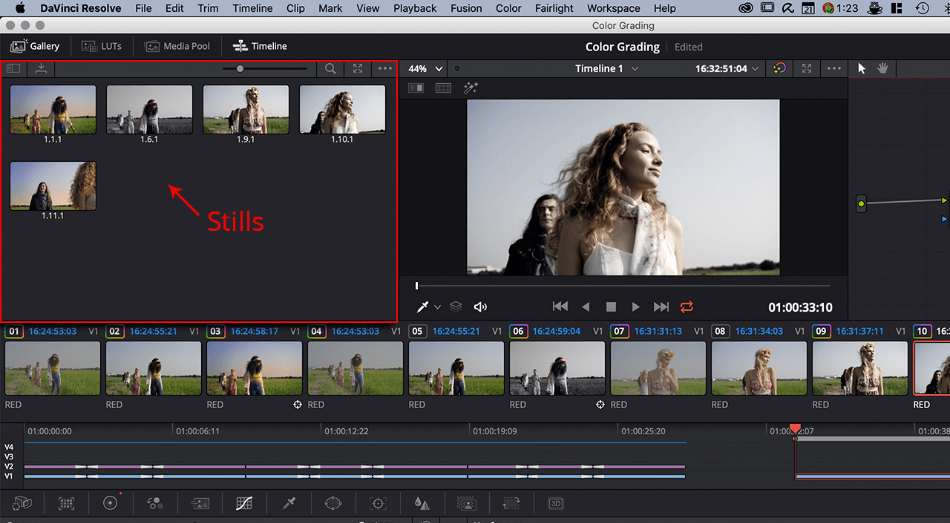
For more complex color correction, the node editor allows you to build a color correction node tree. With simple serial nodes, basic correction can be applied. But when it comes to advanced color correction, the intensive RGB node splitter will do the job.
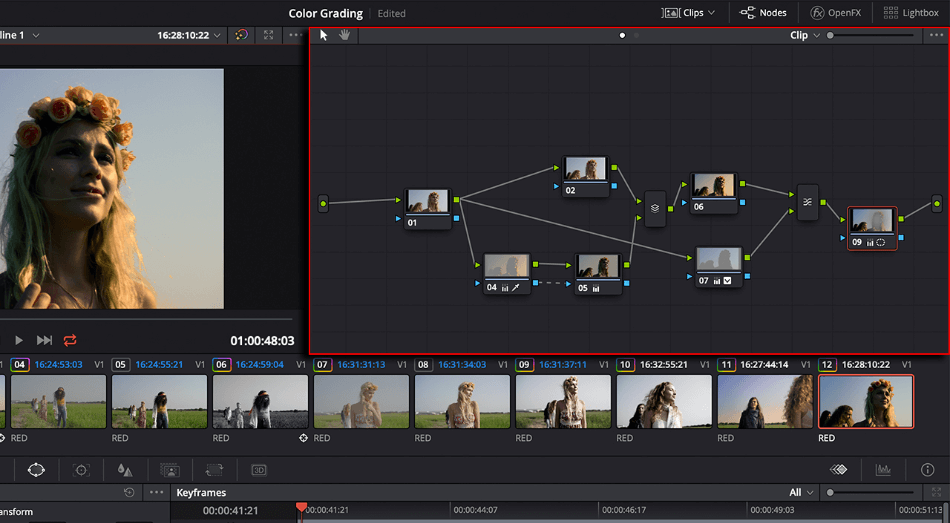
The center and left panels are where the color correction power lies. This is where the color is manipulated. With advanced color wheels, changing the exposure, hue, saturation, and luminance of the mid-tones, shadows, and highlights is simple and effective. The same can be done with the curve but through a different method, churning out different results.
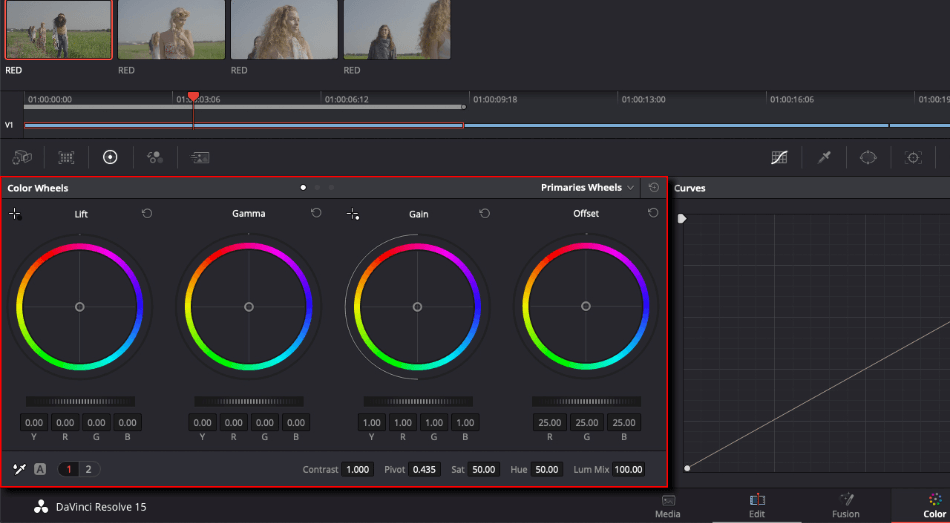
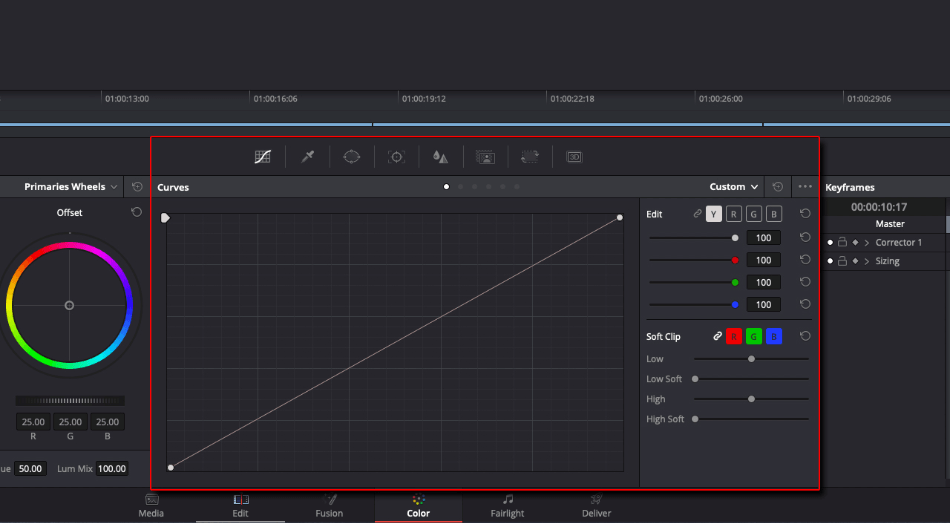
DaVinci’s color timeline allows you to quick-view different clips and color correction effects applied to each. The thumbnails in the timeline show which effect has been applied, if any. This could be helpful if any clips were missed in the correction process.
Another helpful and advanced tool is the keyframe editor. This allows colorists and video editors to gradually change the color correction applied to the clip throughout its duration. This can be super helpful for clips that have minor or even drastic lighting changes within, making it look like one exposure setup throughout, no matter the movements.
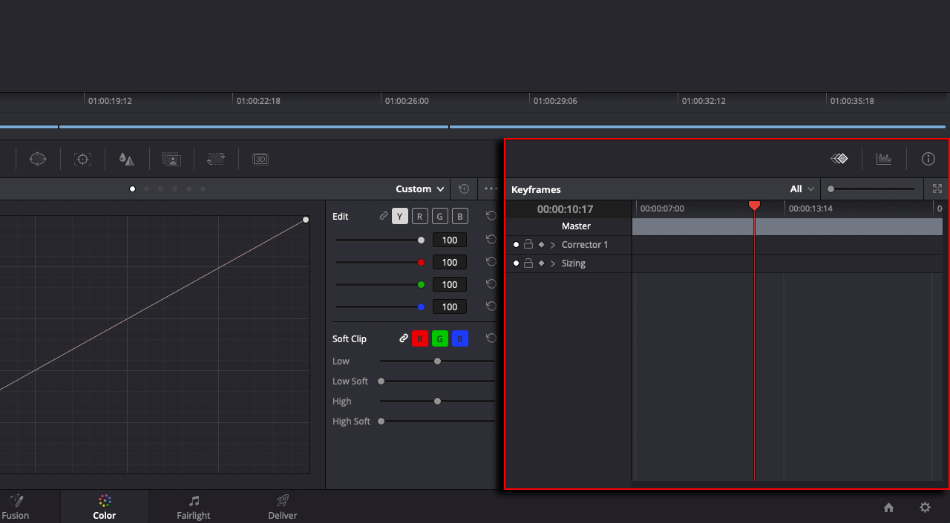
The effects and features discussed here just scratch the surface of what DaVinci Resolve color correction interface is capable of. This makes DaVinci the better of the two programs for coloring footage.
Winner: DaVinci Resolve
4. Audio
Because a project with low-quality footage and high-quality audio is considered higher production value than the inverse, audio is of the utmost importance when video editing.
It’s definitely a tossup between whether DaVinci or Final Cut has better audio engineering tools. However, it’s likely that both of these programs have what you need for a simple production. Both offer a wide array of audio effects, gain, distortion, and much more.
On the one hand, Final Cut Pro’s audio features are easy to use and simple. On the other, DaVinci Resolve’s audio features definitely require more learning, but they offer many more capabilities.
One tool that sets Final Cut Pro apart from DaVinci is assigning audio roles. With this feature, you can differentiate your music, dialogue, sound effects, and more. By compartmentalizing these, many of the audio confusion can be fixed with one simple organization of layers and roles.
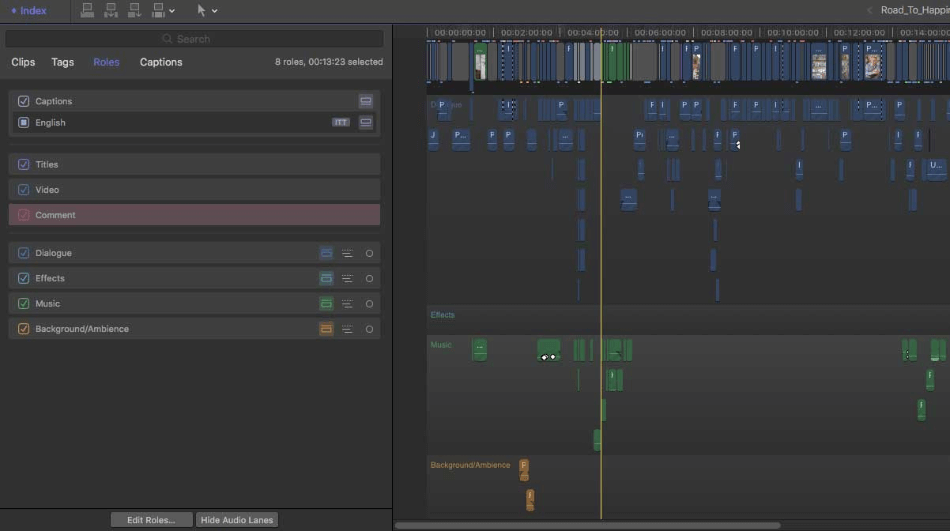
Another commonly used Final Cut Pro audio effect is automatic fix-and-analyze audio. With this, one simple implementation will solve many audio issues and dramatically improve audio quality. This won’t, however, turn your production into a masterpiece. That will require the manual use of a few different sound effects, at the very least. Nevertheless, this is a quick and simple fix for many audio issues and offers fast improvement.
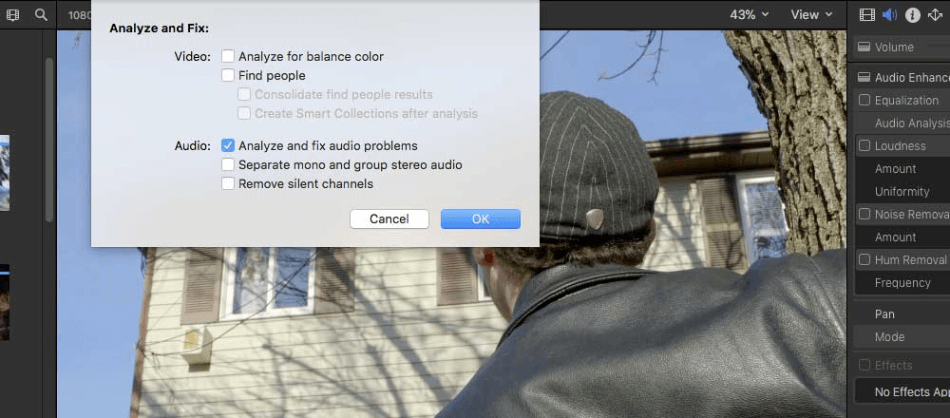
DaVinci also has its fair share of nifty audio tricks in its Fairlight audio interface. One of these is the normalization effect. With this tool, the peaks of an audio clip can be normalized to match the average volume at other places within the clips to make them sound natural.
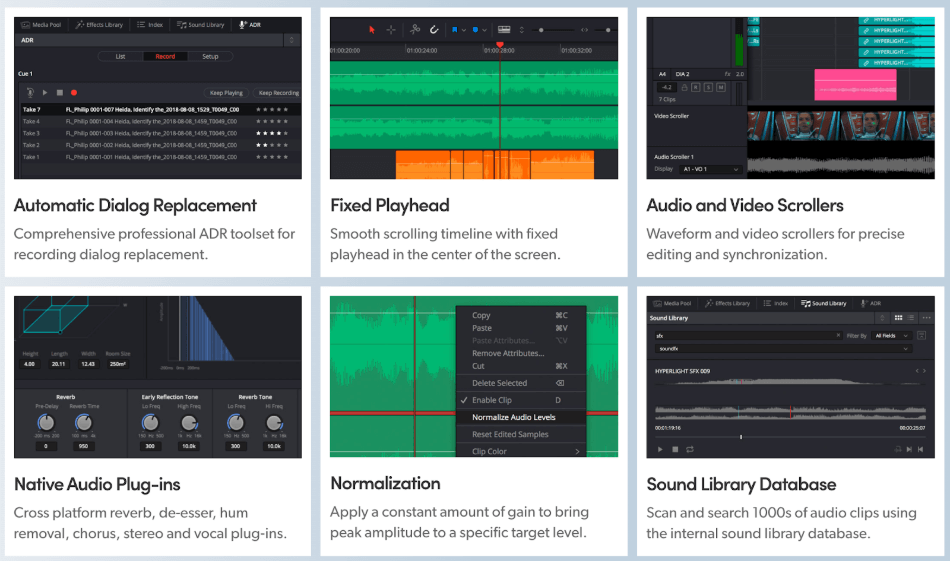
DaVinci’s ADR features allow you to replace the dialogue in a scene to create perfect audio quality on dialogue. It is possible, of course, but this particular feature is not in any other mainstream video-editing platform.
The tools offered in DaVinci are so powerful that you can create soundscape effects for 3D audio as well. This allows you to edit audio for 5.1 surround sound and 22.2.
Winner: Tie
5. Tools
The tools offered in both Final Cut Pro and DaVinci are extensive and advanced. But, if we were to choose one program over the other, it would definitely be DaVinci Resolve. In recent years, DaVinci has turned itself from a color correction platform into a full-scale video editing powerhouse, rivaling the best in the business. This is directly attributed to its extensive addition of tools.
DaVinci’s trim edit tool is one of many that set it apart from the pack. When extending the length of a clip, it is generally understood that you must shift all clips over to the left or right before and after manipulating the length of the selected clip. However, with the trim edit tool, you can simply extend or shorten the clip, and the rest of the timeline will follow suit. Doing this many times will save gobs of time.
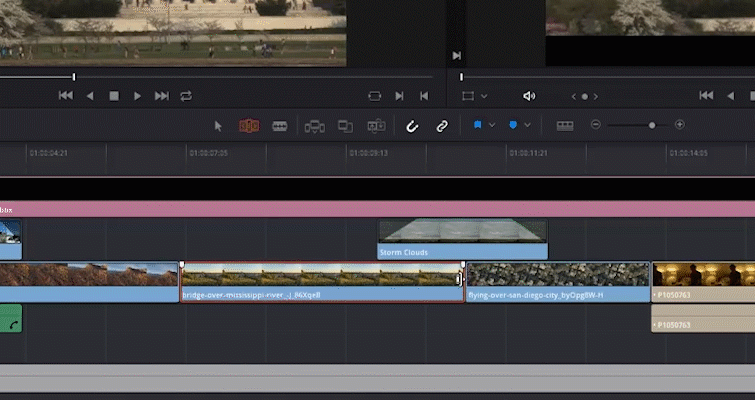
This is just one example of the many innovative tools offered in DaVinci that are designed for the modern user.
Final Cut Pro also has its fair share of advanced tools like its magnetic timeline, multi-cam editing tool, masking, gradients, text guide, magnification, and picture-in-picture tool. These features make it a dynamic platform for users. However, when graduating from Final Cut, the more powerful DaVinci Resolve will be waiting for you.
Winner: DaVinci Resolve
6. Text/Graphics
The text and graphics within both DaVinci and Final Cut Pro are pretty extensive and allow you to do just about whatever you can dream up. However, if we were to choose a better text and graphics video editor for the average user, it would have to be Final Cut Pro.
With a wide array of preset text overlays, Final Cut Pro is designed for an average editor to create advanced and sleek looking titles. On top of that, Final Cut allows the full customization of all text.
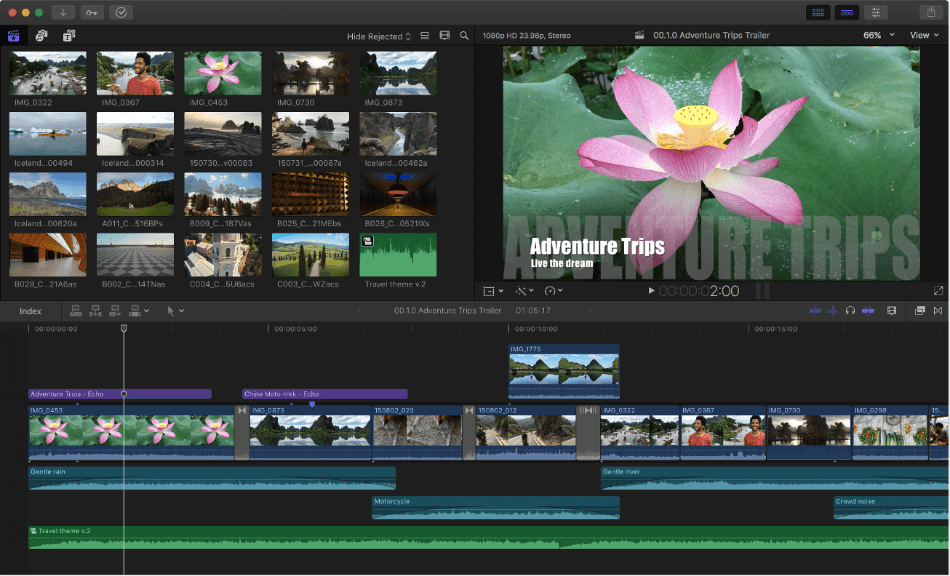
DaVinci also offers a variety of text and graphic features. However, because it is a somewhat newer program, the kinks are still being worked out. You are capable of adding customizable text, graphics, and compositing, but the smoothness isn’t ideal, and the learning curve is steep.
One cool feature in both Final Cut and DaVinci is that you can save an already existing title for custom text in a media pool for easy access in the future.
Winner: Final Cut Pro X
7. Pricing
| Product | Regular Price | Discounted Price |
| Adobe Creative Cloud | $52.99/month | Check here |
| Final Cut Pro | $299.99 (one-time) | No Discount |
| DaVinci Resolve | $299.99 (one-time) | No Discount |
Both Final Cut Pro X and DaVinci Resolve are on the market for a price tag of $299.

DaVinci Resolve is also offered for free with the purchase of many Blackmagic cinema cameras. As DaVinci is the product of Blackmagic, this makes the program extra seamless when used simultaneously with any Blackmagic camera.
Winner: Tie
Final Thoughts
Choosing a video editing platform involves analyzing your needs and ambitions, as each editing program is designed for a slightly different user.
In this case, Final Cut Pro is designed for a Mac user and potentially new filmmaker who plans to shoot, edit, and release a video all by themselves. Final Cut Pro may also be for a professional editor that prefers the magnetic timeline, or isn’t interested in project sharing, as that is complicated and clunky.
DaVinci Resolve is made for a professional video editor or someone with professional ambitions. DaVinci Resolve is also ideal for a professional colorist looking to get into video editing or a video editor looking to get skilled in color correction.
Overall, if you’re looking for a powerful video editing program with a wide array of features and tools, and that is growing within the industry, DaVinci Resolve is the software for you.
Frequently Asked Questions (FAQs)
DaVinci Resolve is generally not the first choice for beginner editors since it’s an expert editing and color correction software used by industry professionals.
Many professionals use Final Cut Pro X. However, most TV and film editors will work on Premiere Pro, Avid or DaVinci Resolve. Many filmmakers on Youtube like to use Final Cut Pro X for its magnetic timeline.
DaVinci Resolve 16 is an updated version of 15 and comes with many bugs and errors fixed. Most editing programs are constantly being updated and improved. DaVinci is no different.
It can be, yes. It is recommended that you start on a beginner program like iMovie. But with online tutorials covering almost every aspect of the program, Final Cut Pro is a good choice for beginners.

Chris is an LA-based filmmaker and video editor who has a passion for writing and creating video content. He has produced and edited a wide variety of projects, most notably his documentary series “Off the Cuf,” which explores the world’s most fascinating and obscure communities. He has over 10 years of experience under his belt and is known for explaining complex concepts in simple, easy-to-understand way.
He is extremely familiar with all the top video editing software out there such as the Adobe Premiere Pro, Adobe After Effects, Final Cut Pro, iMovie, Adobe Animate, and DaVinci Resolve. Chris also has extensive know-how of top graphic design & photo-editing tools, including Photoshop, GIMP, Canva, Snappa, and more.

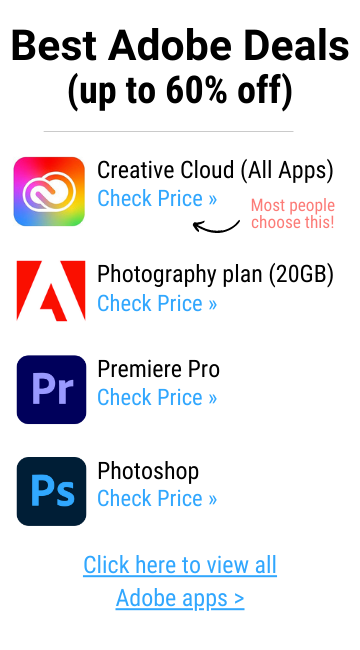

You should fix that Final Cut Pro X can only be use in macOS.
Really? Davinci Resolve Studio is $299 and has extra features. Davinci Resolve is free and is fully featured and is enough for most people. Looks like you are an Apple Shill.
The author said that Davinci is a better program what kind of shill would say that ?
Yes, the article forgets that Resolve has a Free version. zero cost. Also Resolve runs on Linux, Windows and Mac. Linux is a great platform for Resolve. If you are building out a large system Linux networking and the fact that Linux and hence Resolve can run on very high-performance hardware makes it different from FCPX,
One other thing, Resolve will run on multiple high-end GPS. I just installed a second GPU in my Linux system and Resolve automatically “noticed”. If you have a second, empty PCIe slot on the PC you can get a good performance boost.
It never fails to amaze me the condescending outlook of reviewers when it comes to FCPX … sort of how the candle makers must have thought of Edison. Since when is ease of use somehow inferior, how can simplifying the creative process be bad. Honestly, I find both Premier and Da Vinci cluttered. Also, in the movie and tv realm Avid is so far ahead of the competition at this point in time, that no one else really matters… and this won’t change in the near future, as people in the industry don’t easily embrace change.
Uhh…the FCP timeline is not magnetic. You can split a clip, delete the ‘clip in the middle’ and have it leave a hole (i.e., it won’t always apply ripple editing, which is the proper term).